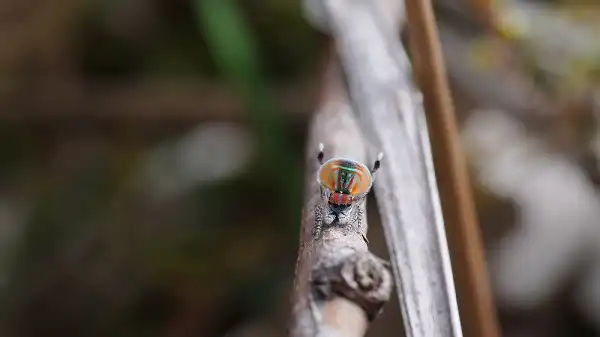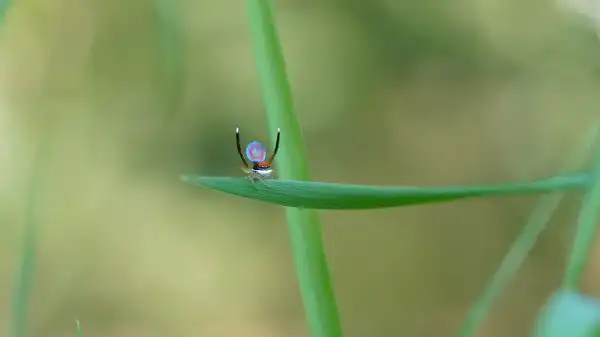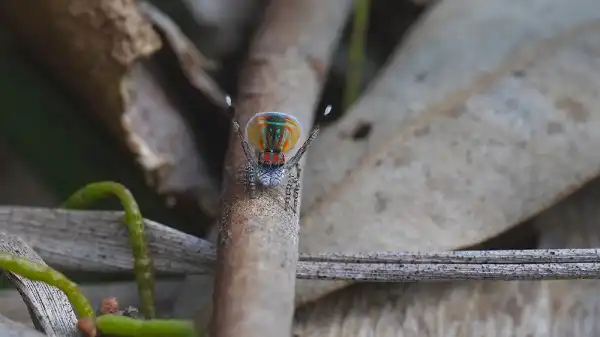Introducing the eye-catching, small but mighty Peacock Spider: a brilliantly colorful arachnid native to Australia that is as remarkable for its beauty as it is for its complex courtship rituals. With its exceptionally long legs and unique color patterns, the peacock spider creates an extraordinary first impression wherever these vibrant critters appear. By exploring this species’ intriguing characteristics, vivid colors, and captivating behavior more closely, we can appreciate all of the fascinating aspects of what makes them so special.

Peacock Spider Description
The Peacock Spider, also known as Maratus volans, is a type of jumping spider that is renowned for its bold and intricate coloring. These arachnids are native to Australia and are typically only found in wooded areas or bush regions. The males of the species are the ones that exhibit a strikingly vibrant color palette, often adorned with hues of blue, red, and yellow, while the females tend to have more muted tones. One of the most intriguing aspects of the Peacock Spider is the male’s unique courtship display. When trying to woo a female, the male will dance and wave his brightly colored abdomen and perform a series of complex movements in a pattern. The dance is both visually impressive and physically demanding, showcasing the male’s agility and athleticism.
Peacock Spider Habitat
The Peacock Spider’s preferred habitat is wooded areas and bush regions of Australia. They are found in the southern and eastern parts of the country, where the climate is warm and humid. These arachnids live on the ground, under leaf litter or rocks, where they create a burrow for shelter and protection. The burrows are typically small, with some measuring only about 1 cm in width and height. In addition to seeking shelter in their burrows, Peacock Spiders also have adaptations that allow them to thrive in their natural habitat. For instance, their bright and distinct color patterns provide camouflage, helping them blend in with the surrounding foliage. This is especially important for the males when they are trying to attract a mate because the bright colors also catch the female’s attention.
Peacock Spider Diet
The Peacock Spider’s diet consists mostly of small insects, such as flies and beetles. These agile hunters capture their prey by patiently waiting until an unsuspecting insect comes within striking distance. Then, with lightning-fast reflexes, they pounce on their prey, immobilizing it with their sharp, venomous fangs. It is fascinating to note that the Peacock Spider’s jumping abilities play a significant role in their hunting strategy. By using their long, slender legs to leap on their prey from a distance, they can catch insects that other spiders would miss. In terms of their nutritional requirements, Peacock Spiders have a high demand for protein, which they obtain from their insect-heavy diet. This protein-rich diet is critical for the development and maintenance of their intricate color patterns, which serve both as a hunting tool and as a means to attract mates during the courtship dance.

Peacock Spider Size
Peacock Spiders, also known as Maratus volans, are small arachnids with males measuring between 3 and 5 millimeters in length, while females are slightly larger, measuring between 5 and 6 millimeters in length. They have a compact body structure with eight legs, which are long and slender, allowing them to jump incredible distances. Despite their small size, Peacock Spiders have a big personality, and their small size does not detract from their impressive and unique appearance. In addition to their remarkable looks, Peacock Spiders have an impressive set of skills that contribute to their survival within their natural environment. Their jumping abilities, for instance, enable them to jump up to 50 times their body length, which is an incredible feat considering their small size.
This unique ability to jump is attributed to the muscles in their back legs, which store and release energy, allowing them to leap extraordinary distances with incredible speed and precision. Overall, while the Peacock Spider may be small in size, it is an incredible creature with a unique appearance, impressive hunting abilities, and remarkable behavioral characteristics that contribute to its survival in its habitat. Therefore, careful conservation measures are essential to preserve the Peacock Spider’s natural environment and safeguard its role in maintaining the ecosystem’s delicate balance.
Peacock Spider Lifespan
Peacock Spider has a relatively short lifespan, with males living for only 6 to twelve months, while females tend to live slightly longer, up to two to 2 years. During their short lives, however, they undertake crucial tasks such as hunting, mating, and reproducing. The Peacock Spider’s short lifespan is attributed to various factors, including its small body size, which makes it more susceptible to environmental stresses such as changes in temperature and humidity. Moreover, their specialized diet of insects exposes them to various predators, leading to frequent predation and accidental deaths. Peacock Spiders have a short but impactful lifespan, characterized by impressive hunting strategies, subsocial behavior, and intricate color patterns. Understanding the unique qualities of these fascinating creatures is critical to preserving their natural habitat and promoting biodiversity in the ecosystem.
Peacock Spider Behavior
Peacock Spiders have an incredible behavioral repertoire that is both fascinating and unique. Their subsocial behavior, in particular, is a remarkable example of their cognitive abilities. Males, in particular, engage in elaborate courtship rituals, that include intricate and specific dance routines, that often span several minutes, and involve a combination of audio and visual signals. These dance routines are designed to attract females, with each species having its unique dance moves and signals. Interestingly, male Peacock Spiders are not only adept at recognizing females but also have a remarkable capacity to remember individual females for up to 3 months. Such memory capacity is remarkable for such a small animal and is attributed to their high cognitive skills, which allow them to store and retrieve information, even in the absence of visual cues. Moreover, in addition to their courtship behavior, Peacock Spiders also display a range of defensive strategies designed to protect themselves from predators. For instance, when threatened or attacked, Peacock Spiders will raise their legs and flagellum and stand on their hind legs. This stance is meant to make them appear larger and more intimidating, thereby deterring potential predators.

Peacock Spider Speed
Peacock Spiders may be known for their intricate dances and colorful patterns, but they are also quite speedy creatures. In fact, these tiny arachnids are some of the fastest spiders in the world! With their short legs and small bodies, Peacock Spiders may not seem like they would be fast movers, but they are surprisingly quick. Their speed helps them to evade predators and catch their prey, which is critical for their survival in their natural habitat. Research has shown that different species of Peacock Spiders have varying speeds. For example, the Maratus personatus species can move at a top speed of up to 13.5 body lengths per second, while the Maratus pardus can reach speeds of up to 15.6 body lengths per second. These speeds are particularly impressive given the spiders’ small size, which makes them vulnerable to predators and environmental stresses. Peacock Spiders’ speed is due in part to their lightweight bodies and agile legs. Additionally, their high metabolic rates and efficient respiratory systems provide them with the energy needed for quick bursts of movement.
Peacock Spider Hunting
Peacock Spiders are formidable predators, despite their diminutive size. These tiny arachnids use a variety of hunting techniques to capture their prey, which consists mostly of other small insects and arthropods. One of the most impressive hunting behaviors exhibited by Peacock Spiders is their ability to detect and ambush prey. These spiders have excellent vision and are able to spot their prey from a distance, thanks to their large, forward-facing eyes. Once they have spotted their target, they will stealthily approach, using their agile legs to maneuver into position. Then, with lightning-fast reflexes, they will pounce on their prey, immobilizing it with a venomous bite. Despite their impressive hunting abilities, Peacock Spiders are also preyed upon by a variety of larger animals, including birds, reptiles, and mammals. To avoid becoming someone else’s meal, Peacock Spiders are constantly on the lookout for danger, using their advanced sensory abilities to detect approaching predators. When threatened, they will use their defensive techniques to deter attackers and escape to safety.
Peacock Spider Mating and Reproduction
While Peacock Spiders may be adept hunters, they are also incredibly skilled at wooing potential mates. Male spiders of many species will perform elaborate courtship dances before engaging in mating with females. These performances often involve colorful patterns on the spider’s abdomen and intricate leg movements that can last up to several minutes. Once a male has successfully impressed a female, he will then use his pedipalps (specialized appendages) to insert sperm into her reproductive organs. The fertilized eggs are then laid by the female and left to develop outside of her body until they hatch as fully developed young spiders.

Conclusion
The Peacock Spiders are a remarkable group of creatures, boasting impressive speed and agility as well as complex hunting strategies. Their delicate and highly specialized adaptations make them an important part of many ecosystems, helping to maintain the balance between predator and prey. As we continue to learn more about these fascinating arachnids, we can gain deeper insight into the intricate ways in which nature works.
Frequently Asked Question

